Abstract
1. The aim of the present experiments was to determine whether 5-HT1A receptors play a role in the control of the reflex activation of pulmonary vagal motoneurones. This was carried out by investigating the effects of intracisternal injections (i.c.) of the 5-HT1A receptor ligands, 8-OH-DPAT (50 micrograms kg-1), buspirone (200 micrograms kg-1), WAY-100635 (100 micrograms kg-1), methiothepin (200 micrograms kg-1) and (-)-pindolol (100 micrograms kg-1) and the 5-HT2 receptor antagonist, cinanserin (200 micrograms kg-1), on the reflex bronchoconstriction evoked by inhaled capsaicin aerosol in alpha-chloralose anaesthetized, neuromuscularly blocked and artificially ventilated cats. Recordings were made of heart rate, blood pressure and upper tracheal pressure. 2. Central application of all the 5-HT1A receptor antagonists (methiothepin, WAY-100635 and (-)-pindolol) attenuated the reflex bronchoconstriction in the upper trachea. However, the same dose of WAY-100635 given i.v. had no effect on this reflex bronchoconstriction. The 5-HT1A receptor agonist, 8-OH-DPAT (50 micrograms kg-1) given i.c., potentiated the capsaicin-evoked reflex bronchoconstriction, whereas buspirone (200 micrograms kg-1) i.c. had no effect. The 5-HT2 receptor antagonist, cinanserin (200 micrograms kg-1) also had no effect. 3. It is concluded that the reflex excitation of pulmonary vagal motoneurones by inhaled capsaicin in alpha-chloralose anaesthetized cats involves the activation of central 5-HT1A receptors.
Full text
PDF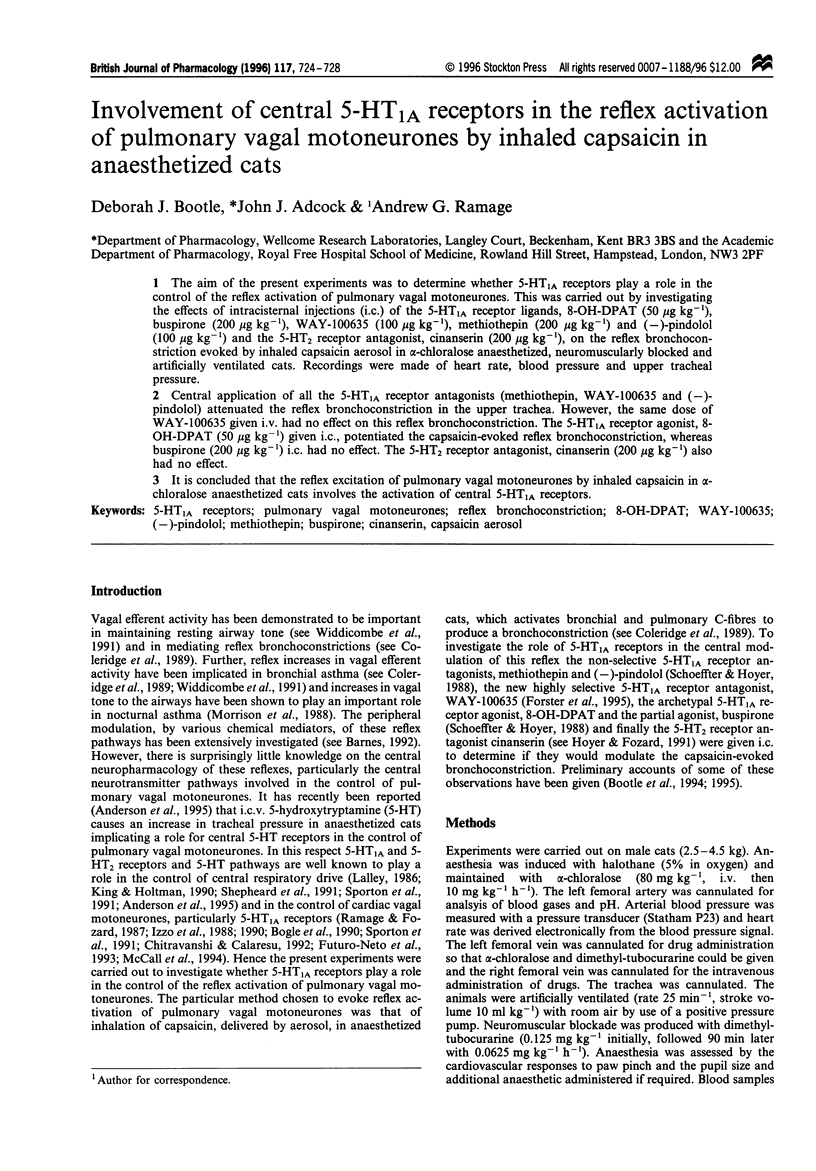
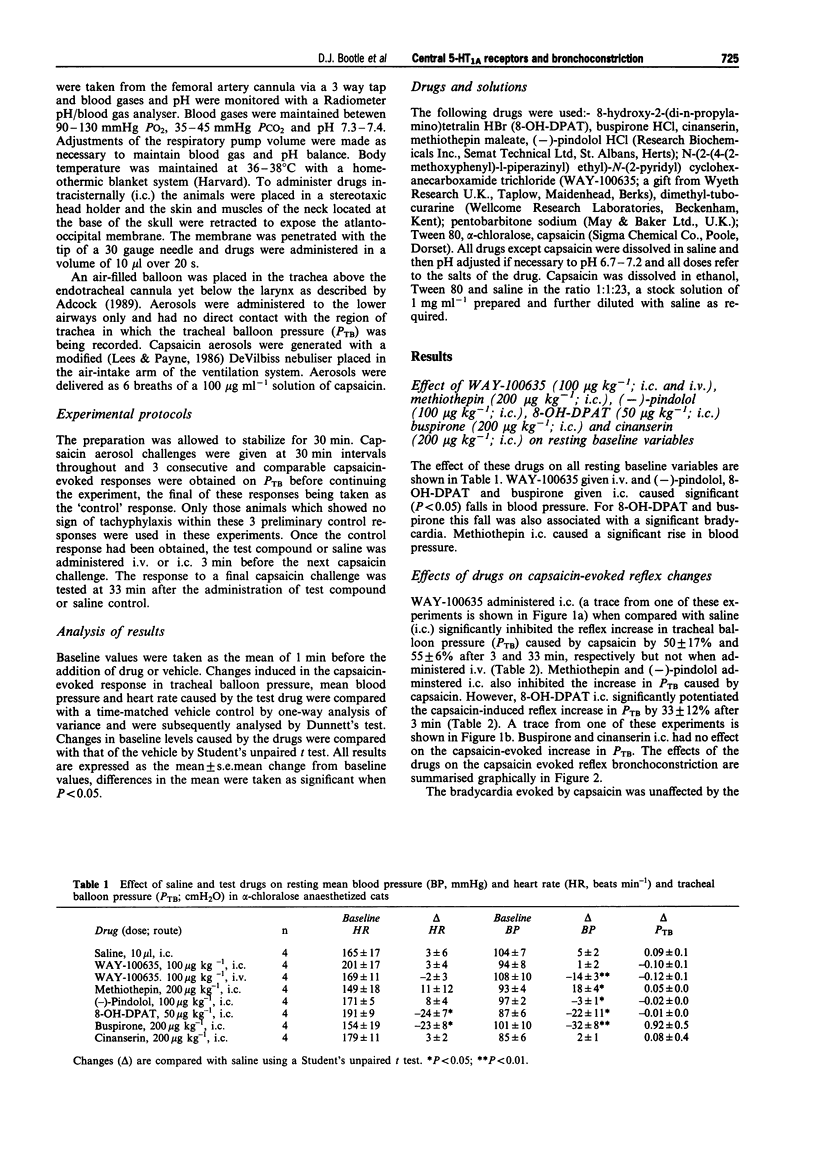
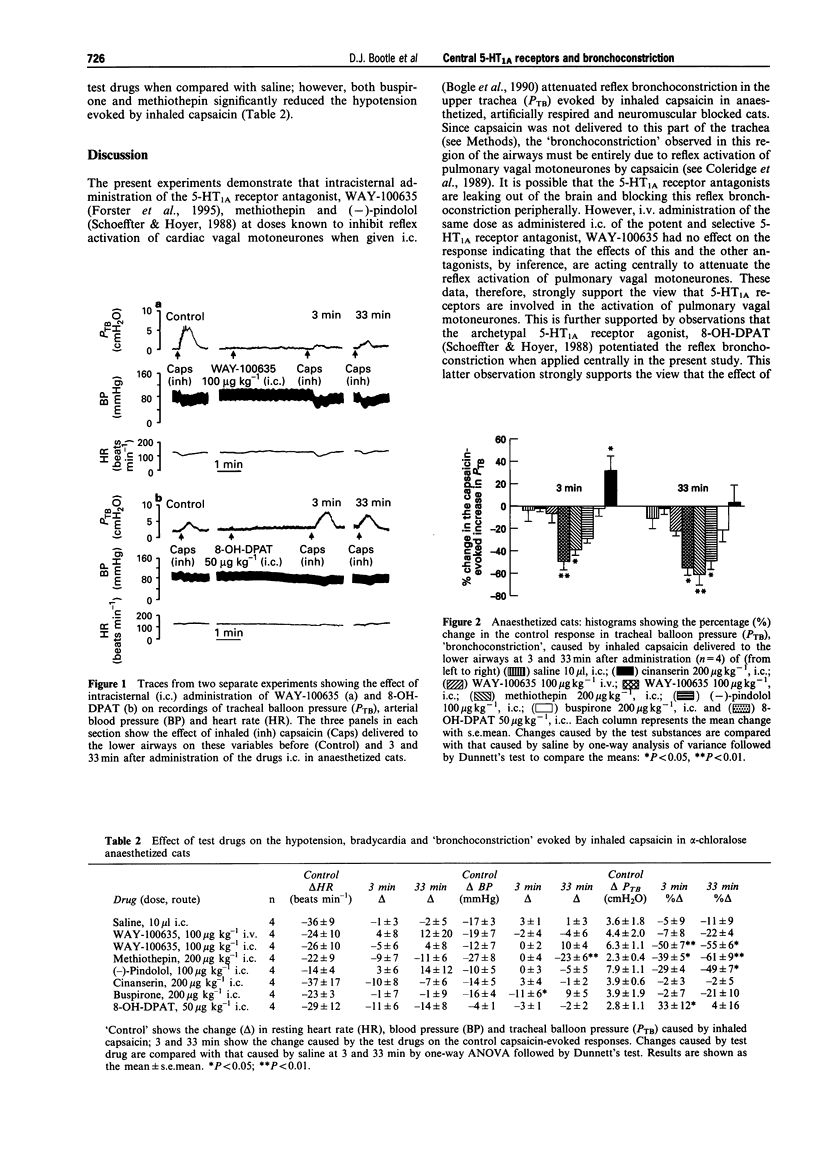
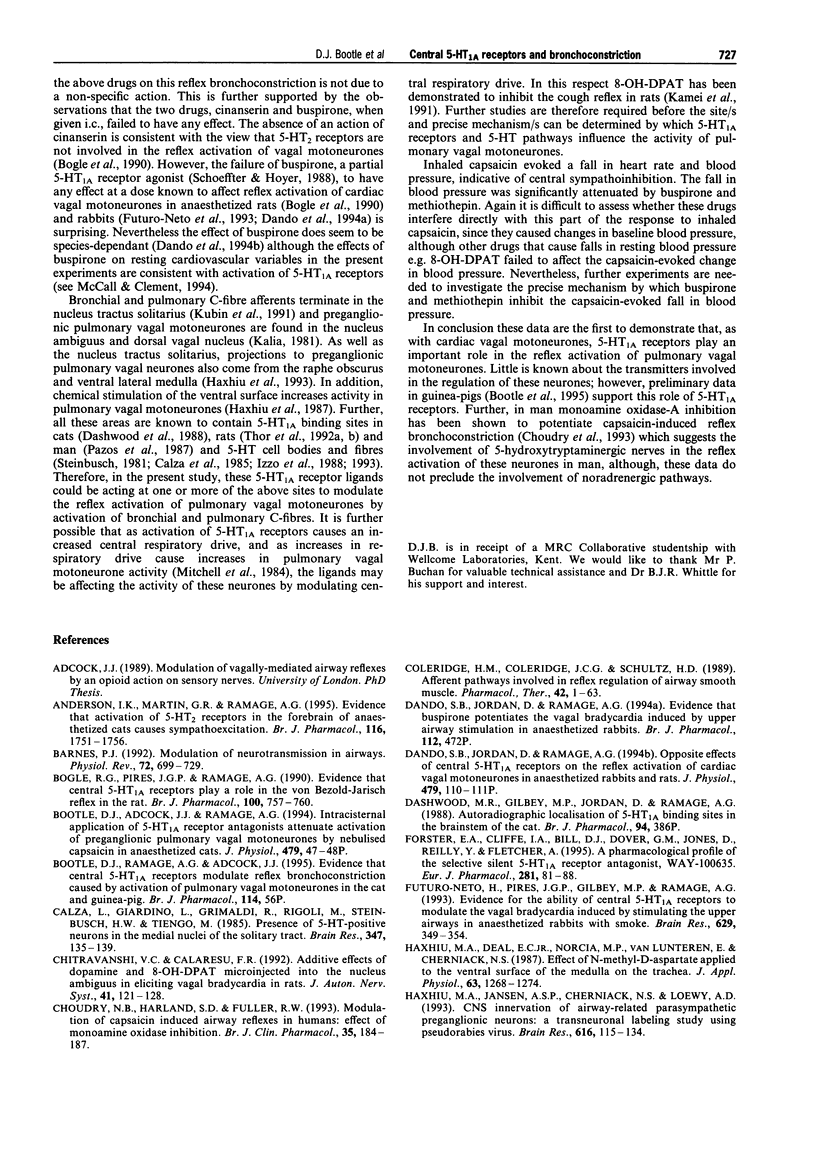
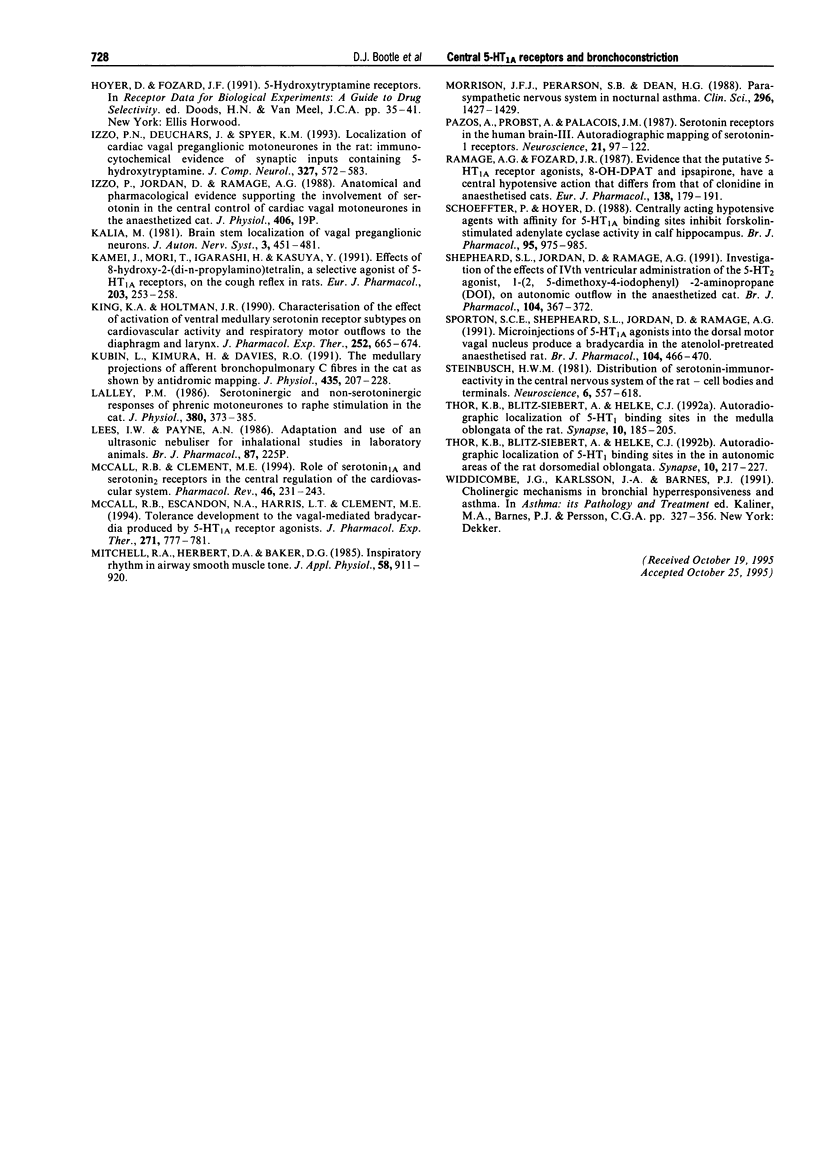
Selected References
These references are in PubMed. This may not be the complete list of references from this article.
- Anderson I. K., Martin G. R., Ramage A. G. Evidence that activation of 5-HT2 receptors in the forebrain of anaesthetized cats causes sympathoexcitation. Br J Pharmacol. 1995 Sep;116(2):1751–1756. doi: 10.1111/j.1476-5381.1995.tb16658.x. [DOI] [PMC free article] [PubMed] [Google Scholar]
- Barnes P. J. Modulation of neurotransmission in airways. Physiol Rev. 1992 Jul;72(3):699–729. doi: 10.1152/physrev.1992.72.3.699. [DOI] [PubMed] [Google Scholar]
- Bogle R. G., Pires J. G., Ramage A. G. Evidence that central 5-HT1A-receptors play a role in the von Bezold-Jarisch reflex in the rat. Br J Pharmacol. 1990 Aug;100(4):757–760. doi: 10.1111/j.1476-5381.1990.tb14088.x. [DOI] [PMC free article] [PubMed] [Google Scholar]
- Calzà L., Giardino L., Grimaldi R., Rigoli M., Steinbusch H. W., Tiengo M. Presence of 5-HT-positive neurons in the medial nuclei of the solitary tract. Brain Res. 1985 Nov 11;347(1):135–139. doi: 10.1016/0006-8993(85)90900-x. [DOI] [PubMed] [Google Scholar]
- Chitravanshi V. C., Calaresu F. R. Additive effects of dopamine and 8-OH-DPAT microinjected into the nucleus ambiguus in eliciting vagal bradycardia in rats. J Auton Nerv Syst. 1992 Nov;41(1-2):121–127. doi: 10.1016/0165-1838(92)90134-3. [DOI] [PubMed] [Google Scholar]
- Choudry N. B., Studham J., Harland D., Fuller R. W. Modulation of capsaicin induced airway reflexes in humans: effect of monoamine oxidase inhibition. Br J Clin Pharmacol. 1993 Feb;35(2):184–187. doi: 10.1111/j.1365-2125.1993.tb05684.x. [DOI] [PMC free article] [PubMed] [Google Scholar]
- Coleridge H. M., Coleridge J. C., Schultz H. D. Afferent pathways involved in reflex regulation of airway smooth muscle. Pharmacol Ther. 1989;42(1):1–63. doi: 10.1016/0163-7258(89)90021-1. [DOI] [PubMed] [Google Scholar]
- Forster E. A., Cliffe I. A., Bill D. J., Dover G. M., Jones D., Reilly Y., Fletcher A. A pharmacological profile of the selective silent 5-HT1A receptor antagonist, WAY-100635. Eur J Pharmacol. 1995 Jul 25;281(1):81–88. doi: 10.1016/0014-2999(95)00234-c. [DOI] [PubMed] [Google Scholar]
- Futuro-Neto H. A., Pires J. G., Gilbey M. P., Ramage A. G. Evidence for the ability of central 5-HT1A receptors to modulate the vagal bradycardia induced by stimulating the upper airways of anesthetized rabbits with smoke. Brain Res. 1993 Dec 3;629(2):349–354. doi: 10.1016/0006-8993(93)91345-s. [DOI] [PubMed] [Google Scholar]
- Haxhiu M. A., Deal E. C., Jr, Norcia M. P., van Lunteren E., Cherniack N. S. Effect of N-methyl-D-aspartate applied to the ventral surface of the medulla on the trachea. J Appl Physiol (1985) 1987 Sep;63(3):1268–1274. doi: 10.1152/jappl.1987.63.3.1268. [DOI] [PubMed] [Google Scholar]
- Haxhiu M. A., Jansen A. S., Cherniack N. S., Loewy A. D. CNS innervation of airway-related parasympathetic preganglionic neurons: a transneuronal labeling study using pseudorabies virus. Brain Res. 1993 Jul 30;618(1):115–134. doi: 10.1016/0006-8993(93)90435-p. [DOI] [PubMed] [Google Scholar]
- Izzo P. N., Deuchars J., Spyer K. M. Localization of cardiac vagal preganglionic motoneurones in the rat: immunocytochemical evidence of synaptic inputs containing 5-hydroxytryptamine. J Comp Neurol. 1993 Jan 22;327(4):572–583. doi: 10.1002/cne.903270408. [DOI] [PubMed] [Google Scholar]
- Kalia M. Brain stem localization of vagal preganglionic neurons. J Auton Nerv Syst. 1981 Apr;3(2-4):451–481. doi: 10.1016/0165-1838(81)90081-3. [DOI] [PubMed] [Google Scholar]
- Kamei J., Mori T., Igarashi H., Kasuya Y. Effects of 8-hydroxy-2-(di-n-propylamino)tetralin, a selective agonist of 5-HT1A receptors, on the cough reflex in rats. Eur J Pharmacol. 1991 Oct 15;203(2):253–258. doi: 10.1016/0014-2999(91)90721-2. [DOI] [PubMed] [Google Scholar]
- Kawai T., Watanabe M. Blockade of Ca-activated K conductance by apamin in rat sympathetic neurones. Br J Pharmacol. 1986 Jan;87(1):225–232. doi: 10.1111/j.1476-5381.1986.tb10175.x. [DOI] [PMC free article] [PubMed] [Google Scholar]
- King K. A., Holtman J. R., Jr Characterization of the effects of activation of ventral medullary serotonin receptor subtypes on cardiovascular activity and respiratory motor outflow to the diaphragm and larynx. J Pharmacol Exp Ther. 1990 Feb;252(2):665–674. [PubMed] [Google Scholar]
- Kubin L., Kimura H., Davies R. O. The medullary projections of afferent bronchopulmonary C fibres in the cat as shown by antidromic mapping. J Physiol. 1991 Apr;435:207–228. doi: 10.1113/jphysiol.1991.sp018506. [DOI] [PMC free article] [PubMed] [Google Scholar]
- Lalley P. M. Serotoninergic and non-serotoninergic responses of phrenic motoneurones to raphe stimulation in the cat. J Physiol. 1986 Nov;380:373–385. doi: 10.1113/jphysiol.1986.sp016291. [DOI] [PMC free article] [PubMed] [Google Scholar]
- McCall R. B., Clement M. E. Role of serotonin1A and serotonin2 receptors in the central regulation of the cardiovascular system. Pharmacol Rev. 1994 Sep;46(3):231–243. [PubMed] [Google Scholar]
- McCall R. B., Escandon N. A., Harris L. T., Clement M. E. Tolerance development to the vagal-mediated bradycardia produced by 5-HT1A receptor agonists. J Pharmacol Exp Ther. 1994 Nov;271(2):776–781. [PubMed] [Google Scholar]
- Mitchell R. A., Herbert D. A., Baker D. G. Inspiratory rhythm in airway smooth muscle tone. J Appl Physiol (1985) 1985 Mar;58(3):911–920. doi: 10.1152/jappl.1985.58.3.911. [DOI] [PubMed] [Google Scholar]
- Morrison J. F., Pearson S. B., Dean H. G. Parasympathetic nervous system in nocturnal asthma. Br Med J (Clin Res Ed) 1988 May 21;296(6634):1427–1429. doi: 10.1136/bmj.296.6634.1427. [DOI] [PMC free article] [PubMed] [Google Scholar]
- Pazos A., Probst A., Palacios J. M. Serotonin receptors in the human brain--III. Autoradiographic mapping of serotonin-1 receptors. Neuroscience. 1987 Apr;21(1):97–122. doi: 10.1016/0306-4522(87)90326-5. [DOI] [PubMed] [Google Scholar]
- Ramage A. G., Fozard J. R. Evidence that the putative 5-HT1A receptor agonists, 8-OH-DPAT and ipsapirone, have a central hypotensive action that differs from that of clonidine in anaesthetised cats. Eur J Pharmacol. 1987 Jun 19;138(2):179–191. doi: 10.1016/0014-2999(87)90431-6. [DOI] [PubMed] [Google Scholar]
- Schoeffter P., Hoyer D. Centrally acting hypotensive agents with affinity for 5-HT1A binding sites inhibit forskolin-stimulated adenylate cyclase activity in calf hippocampus. Br J Pharmacol. 1988 Nov;95(3):975–985. doi: 10.1111/j.1476-5381.1988.tb11728.x. [DOI] [PMC free article] [PubMed] [Google Scholar]
- Shepheard S. L., Jordan D., Ramage A. G. Investigation of the effects of IVth ventricular administration of the 5-HT2 agonist, 1-(2,5-dimethoxy-4-iodophenyl)-2-aminopropane (DOI), on autonomic outflow in the anaesthetized cat. Br J Pharmacol. 1991 Oct;104(2):367–372. doi: 10.1111/j.1476-5381.1991.tb12437.x. [DOI] [PMC free article] [PubMed] [Google Scholar]
- Sporton S. C., Shepheard S. L., Jordan D., Ramage A. G. Microinjections of 5-HT1A agonists into the dorsal motor vagal nucleus produce a bradycardia in the atenolol-pretreated anaesthetized rat. Br J Pharmacol. 1991 Oct;104(2):466–470. doi: 10.1111/j.1476-5381.1991.tb12452.x. [DOI] [PMC free article] [PubMed] [Google Scholar]
- Steinbusch H. W. Distribution of serotonin-immunoreactivity in the central nervous system of the rat-cell bodies and terminals. Neuroscience. 1981;6(4):557–618. doi: 10.1016/0306-4522(81)90146-9. [DOI] [PubMed] [Google Scholar]
- Thor K. B., Blitz-Siebert A., Helke C. J. Autoradiographic localization of 5HT1 binding sites in autonomic areas of the rat dorsomedial medulla oblongata. Synapse. 1992 Mar;10(3):217–227. doi: 10.1002/syn.890100305. [DOI] [PubMed] [Google Scholar]
- Thor K. B., Blitz-Siebert A., Helke C. J. Autoradiographic localization of 5HT1 binding sites in the medulla oblongata of the rat. Synapse. 1992 Mar;10(3):185–205. doi: 10.1002/syn.890100303. [DOI] [PubMed] [Google Scholar]


